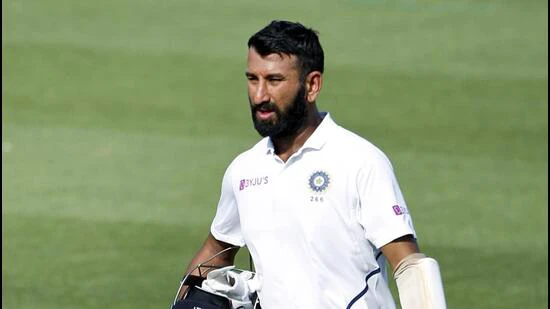Kolkata: He was Indian Test cricket’s sturdiest defence in the last decade. Cheteshwar Pujara, among the most classical modern batters who enriched Test batting with grit and technique while refusing to yield to the increasing lure of strike rate and hundred conversion rate, has retired from all cricket.
Pujara was India’s last Test specialist, an outlier at a time when cricket had moved irreversibly into the fast lane. He never played a T20I, and the last of his only five ODIs came in 2014. However, most of India’s finest Test wins for over a decade has the Pujara stamp.
His cricket lessons honed under his diligent father Arvind, a first-class player, Pujara rose from the dusty, flat pitches of Rajkot to become a batter who bowlers around the world found tough to dislodge. One of the first casualties of India’s Test transition, Pujara’s Test career ended with 7,195 runs and 19 hundreds at a solid average of 43.60. Don’t read too much into the average though, for Pujara’s legacy runs deeper.
He was India’s first and last line of defence on pitches as varied as they could get. Since his Test debut in October 2010, only six batters have faced more deliveries than Pujara’s 15,797 in Tests – Joe Root, Steve Smith, Kane Williamson, Alastair Cook, Virat Kohli and Azhar Ali. This, despite Pujara not playing international cricket in over two years.
His defiance was often dull and rarely breathtaking, yet effective. Grind out the bowling, leave the deliveries outside off-stump, play out time till it started playing to his strength -Pujara was all about the process that makes Test batting unique and coveted. If that meant taking blows on his body as India’s anchor in the Gabba victory, Pujara did that happily.
It famously took Pujara 53 balls to score his first run in the first innings of the 2018 Johannesburg Test on a green, devious pitch. When he eventually opened his account, Pujara’s teammates celebrated, but South Africa knew it to be an ominous start. Pujara ended with a strike rate of 27.93 that innings. India won the Test.
It’s perhaps not a coincidence that Pujara has woven the same pattern in some of India’s most memorable overseas victories. In all the innings from Indian batters facing at least 150 balls, three of Pujara’s lowest strike rates have come at Lord’s (21.84) in 2021, Gabba (26.54) in 2021 and Johannesburg in 2018. Reticent but resolute, Pujara’s preferred mode of expression was just to bat hours. Only when he was absolutely sure that the opposition had been ground to dust would Pujara unveil his strokes, skip down the crease to the spinner or rock back and cut fast bowlers behind point.
It was the perfect foil to Kohli’s aggression, and even though there was a time when Kohli wanted Pujara to join his tribe, better sense prevailed eventually. For no one could dead bat fast bowlers with minimum fuss like Pujara. It was the kind of dirty work Pujara would unfailingly show up for every day even as his more popular teammates would often walk away with the honours.
Rarely would he give an inch to spinners though, as Nathan Lyon would vouch for in the 2018-19 series, muttering “Aren’t you bored of batting now?” to Pujara. That tour, Pujara scored 521 runs while facing a record 1,258 balls as India won their first ever series in Australia, 71 years since they began touring the country. Kohli was second best on that tour, facing 684 balls.
Australia had got a taste of what was coming in 2017-18 when in Ranchi Pujara defied their unrelenting fast bowlers to score a double hundred and add 199 runs with Wriddhiman Saha for the seventh wicket. Such was the despair in the Australian ranks that Pujara was told “Now if you don’t get out, we’ll have to ask for wheelchairs.”
Had it not been for that double hundred, the Ranchi Test wouldn’t have been drawn. And had it not been for that draw, India couldn’t have won the series by defeating Australia in the final Test at Dharamsala. To replicate that tenacity in Australia in a year’s time, and again in 2021 when Pujara single-handedly repelled them in Sydney and Brisbane, was epic. It was out of sheer respect for what he had achieved on that tour that Chennai Super Kings decided to give him an IPL contract in 2021 though everyone knew he won’t get a game.
It was unfair to saddle Pujara with the expectations that he would be the ideal successor to Rahul Dravid at No.3. He was probably a bit suspect against the moving ball, as his average of 29 in England, 20 in New Zealand and 28.15 in South Africa might suggest. In India (52.58) and Sri Lanka (90.80) however Pujara was a nightmare for the bowlers.
But he was most prolific against Australia, averaging 47.28 away, more than Dravid (41.64) and Kohli (46.72). Six hundreds in a winning cause as well, behind only Sachin Tendulkar (9) and Rahul Dravid (7), Pujara was the hero India didn’t always know they needed.
It probably explains why Pujara’s transition wasn’t handled too well. There was a slump in the final years, but every time he was dropped, Pujara hit the domestic circuit in the hope of getting picked again. Only this January did he score 99 in a Ranji Trophy game against Assam. A couple of months before that came a staggering 234 against Chhattisgarh, sparking chatter that he could provide the stability India desperately needed after faltering against New Zealand at home. That chance, however, never came.
